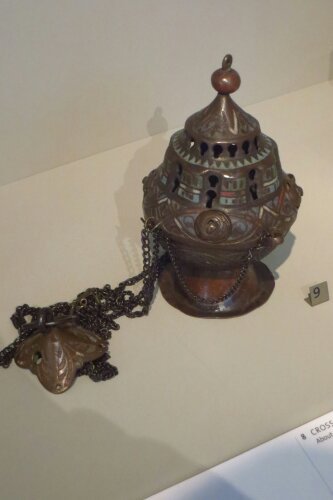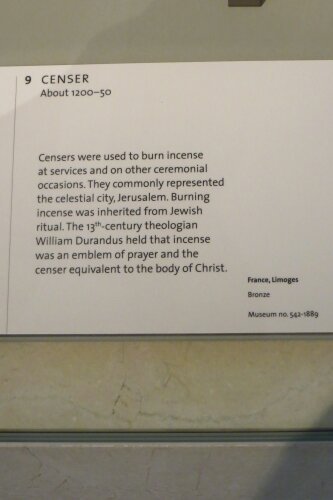Sometimes museums are terribly annoying. I found myself getting all worked up about this thurible.
Well, It wasn’t exactly the thurible that got me worked up but the card next to it.
The caption uses the past tense. “Censors were used…”
Censors are used. It somehow felt so frustrating to look at an object that I could pick up and use in my daily work and which seemed to me to be in as good a state as when it was first made and yet see the caption speaking about the use as being something in the past.
As I looked around the same gallery, all the references to anything liturgical were expressed in the same way:
“Music was important in the Christian liturgy…”
There’s no was about it.


How depressing to think that a place that is meant to bring the past alive prefers to consign the present to some kind of false past.
If the museum is in Glasgow, you might care to invite the curators to experience what they clearly don’t imagine happens at a place like St Mary’s. If it’s not in Glasgow, you might like to invite them to attend their local cathedral for a dose of reality.
I had a similar experience at a lecture on “Anniversaries, feasts and commemoration in the Middle Ages” given by the Department of Continuing Education at Oxford University, in which the lecturer spoke of daily Masses and the celebration of the feast days of the church as though these only happened in the distance past. Still, since Henry VIII banned the teaching of canon law at the two Universities in 1535, I suppose they’re a little behind the times.
Is this at a museum in Edinburgh?
It is the same assumption which made one of my daughter’s lecturers in History of Art walk in front of the high altar in an Italian church during Mass – she, who is not a Christian, remonstrated – apparently however he had no concept that what people were doing there (apart from getting between him and Donatello) was of any importance to them or anybody else.
The errant writer of the card at least knew that a thurible is a “censer”, Mr Provost… To re-use your own words, “It somehow felt so frustrating… to look at a post from a man who uses a censer but thinks it is a censor.”
You are quite right in stating that “Censors are used”, but they are NOT used to waft incense. Censers waft incense – censors stop us telling anybody about it!
(I should perhaps count my blessings… the MC in my parish STILL sends out rubrics for EVERY service insisting that “The Priest will sense the alter.”)
Quite Right, Father. although this particular thuirible looks a little uncared for and could do with a bit of a polish. We at St. Michael and All Angels in Christchurch, New Zealand, are still avid articulators of the thurible – at Sung Mass and Evensong and Benediction – though one of the few, I’m afraid in our Church. We believe its us accompanies the Prayers of Our Lady and the Saints, too.
This, alas is the Victoria and Albert Museum in that London.
> To re-use your own words, “It somehow felt so frustrating… to look at a post from a man who uses a censer but thinks it is a censor.”
Did you not know that the first ancient Roman to swing a thurible was Cato the Censer? Just as Pliny the Elder was the first ancient Roman to be a member of the Church of Scotland . . .
I visited the former Dominican priory in Zwolle, Holland a few years ago. It’s now a museum and I was asked, in front of a perfectly normal-looking chasuble, probably weaved in the 1950’s: ‘Does anyone know what this was for?’
Back in the 1960s I was called upon to serve Mass for a visiting priest, who was one of those old-fashioned Church of Ireland clerics, high and dry in doctrine but knowing nothing of ritual and ceremonial. I had laid out the vestments in the usual way, the maniple, stole and girdle in the IHS shape and the amice on top, its tapes forming a St Andrew’s Cross. Imagine my surprise when the visiting priest took the amice, looked at it in puzzlement and then put it on like an apron, the tapes being the apron strings!